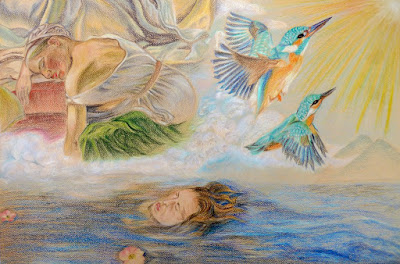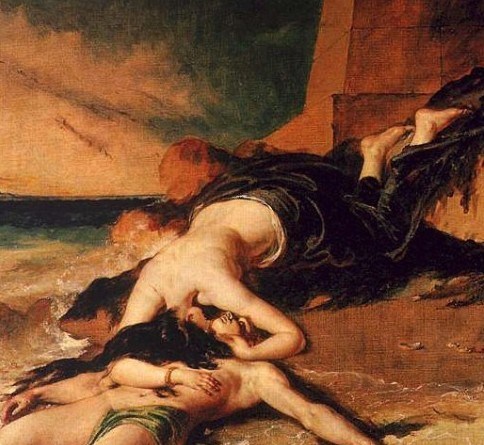ALCYONE was the daughter of Aeolus, guardian of the winds, and Aegiale. She married Ceyx of Trachis, son of the Morning-star, and they were so happy in each other’s company that she daringly called herself Hera, and him Zeus. This naturally vexed the Olympian Zeus and Hera, who let a thunderstorm break over the ship in which Ceyx was sailing to consult an oracle, and drowned him. His ghost appeared to Alcyone who, greatly against her will, had stayed behind in Trachis, whereupon distraught with grief, she leapt into the sea. Some pitying god transformed them both into kingfishers.
b. Now, every winter, the hen-kingfisher carries her dead mate with great wailing to his burial and then, building a closely compacted nest from the thorns of the sea-needle, launches it on the sea, lays her eggs in it, and hatches out her chicks. She does all this in the Halcyon Days-the seven which precede the winter solstice, and the seven which succeed it-while Aeolus forbids his winds to sweep across the waters.
c. But some say that Ceyx was turned into a seamew.
1. The legend of the halcyon’s, or kingfisher’s, nest (which has no foundation in natural history, since the halcyon does not build any kind of nest, but lays eggs in holes by the waterside) can refer only to the birth of the new sacred king at the winter solstice-after the queen who represents his mother, the Moon-goddess, has conveyed the old king’s corpse to a sepulchral island. But because the winter solstice does not always coincide with the same phase of the moon, ‘every year’ must be understood as ‘every Great Year’, of one hundred lunations, in the last of which solar and lunar time were roughly synchronized, and the sacred king’s term ended.
2. Homer connects the halcyon with Alcyone, a title of Meleager’s wife Cleopatra (Iliad), and with a daughter of Aeolus, guardian of the winds. Halcyon cannot therefore mean hal- cyon, ‘sea-hound’, as is usually supposed, but must stand for alcy-one, ‘the queen who wards off evil’. This derivation is confirmed by the myth of Alcyone and Ceyx, and the manner of their punishment by Zeus and Hera. The seamew part of the legend need not be pressed, although this bird, which has a plaintive cry, was sacred to the Sea-goddess Aphrodite, or Leucothea, like the halcyon of Cyprus. It seems that late in the second millennium BC the sea-faring Aeolians, who had agreed to worship the pre-Hellenic Moon-goddess as their divine ancestress and protectress, became tributary to the Zeus-worshipping Achaeans, and were forced to accept the Olympian religion. ‘Zeus’, which according to Johannes Tzetzes, hitherto been a title born by petty kings, was henceforth reserved for the Father of Heaven alone. But in Crete, the ancient mystical tradition that Zeus was born and died annually lingered on into Christian times, and tombs of Zeus were shown at Cnossus, on Mount Ida, and on Mount Dicte, each a different cult-centre. Callimachus was scandalized, and in his Hymn to Zeus wrote: ‘The Cretans are always liars. They have even built thy tomb, O Lord! But thou art not dead, for thou livest for ever.’ This is quoted in Titus.
3. Pliny, who describes the halcyon’s alleged nest in detail-apparently the zoophyte called halcyoneum by Linnaeus-reports that the halcyon is rarely seen, and then only at the two solstices and at the setting of the Pleiades. This proves her to have originally been a manifestation of the Moon-goddess, who was alternately the Goddess of Life-in-Death at the winter solstice, and of Death-in-Life at the summer solstice; and who, every Great Year, early in November, when the Pleiades set, sent the sacred king his death summons.
4. Still another Alcyone, daughter of Pleione (‘sailing queen’) by Atlas, was the leader of the seven Pleiades. The Pleiades’ heliacal rising in May began the navigational year; their setting marked its end, when (as Pliny notes in a passage about the halcyon) a remarkably cold north wind blows. The circumstances of Ceyx’s death show that the Aeolians, who were famous sailors, worshipped the goddess as ‘Alcyone’ because she protected them from rocks and rough weather: Zeus wrecked Ceyx’s ship, in defiance of her powers, by hurling a thunderbolt at it. Yet the halcyon was still credited with the magical power of allaying storms; and its body, when dried, was used as a talisman against Zeus’s lightning-presumably on the ground that where once it strikes it will not strike again. The Mediterranean is inclined to be calm about the time of the winter solstice.
b. Now, every winter, the hen-kingfisher carries her dead mate with great wailing to his burial and then, building a closely compacted nest from the thorns of the sea-needle, launches it on the sea, lays her eggs in it, and hatches out her chicks. She does all this in the Halcyon Days-the seven which precede the winter solstice, and the seven which succeed it-while Aeolus forbids his winds to sweep across the waters.
c. But some say that Ceyx was turned into a seamew.
2. Homer connects the halcyon with Alcyone, a title of Meleager’s wife Cleopatra (Iliad), and with a daughter of Aeolus, guardian of the winds. Halcyon cannot therefore mean hal- cyon, ‘sea-hound’, as is usually supposed, but must stand for alcy-one, ‘the queen who wards off evil’. This derivation is confirmed by the myth of Alcyone and Ceyx, and the manner of their punishment by Zeus and Hera. The seamew part of the legend need not be pressed, although this bird, which has a plaintive cry, was sacred to the Sea-goddess Aphrodite, or Leucothea, like the halcyon of Cyprus. It seems that late in the second millennium BC the sea-faring Aeolians, who had agreed to worship the pre-Hellenic Moon-goddess as their divine ancestress and protectress, became tributary to the Zeus-worshipping Achaeans, and were forced to accept the Olympian religion. ‘Zeus’, which according to Johannes Tzetzes, hitherto been a title born by petty kings, was henceforth reserved for the Father of Heaven alone. But in Crete, the ancient mystical tradition that Zeus was born and died annually lingered on into Christian times, and tombs of Zeus were shown at Cnossus, on Mount Ida, and on Mount Dicte, each a different cult-centre. Callimachus was scandalized, and in his Hymn to Zeus wrote: ‘The Cretans are always liars. They have even built thy tomb, O Lord! But thou art not dead, for thou livest for ever.’ This is quoted in Titus.
3. Pliny, who describes the halcyon’s alleged nest in detail-apparently the zoophyte called halcyoneum by Linnaeus-reports that the halcyon is rarely seen, and then only at the two solstices and at the setting of the Pleiades. This proves her to have originally been a manifestation of the Moon-goddess, who was alternately the Goddess of Life-in-Death at the winter solstice, and of Death-in-Life at the summer solstice; and who, every Great Year, early in November, when the Pleiades set, sent the sacred king his death summons.
4. Still another Alcyone, daughter of Pleione (‘sailing queen’) by Atlas, was the leader of the seven Pleiades. The Pleiades’ heliacal rising in May began the navigational year; their setting marked its end, when (as Pliny notes in a passage about the halcyon) a remarkably cold north wind blows. The circumstances of Ceyx’s death show that the Aeolians, who were famous sailors, worshipped the goddess as ‘Alcyone’ because she protected them from rocks and rough weather: Zeus wrecked Ceyx’s ship, in defiance of her powers, by hurling a thunderbolt at it. Yet the halcyon was still credited with the magical power of allaying storms; and its body, when dried, was used as a talisman against Zeus’s lightning-presumably on the ground that where once it strikes it will not strike again. The Mediterranean is inclined to be calm about the time of the winter solstice.


Comments
Post a Comment